cooling JEEP WRANGLER 2015 JK / 3.G User Guide
[x] Cancel search | Manufacturer: JEEP, Model Year: 2015, Model line: WRANGLER, Model: JEEP WRANGLER 2015 JK / 3.GPages: 156, PDF Size: 23.54 MB
Page 109 of 156
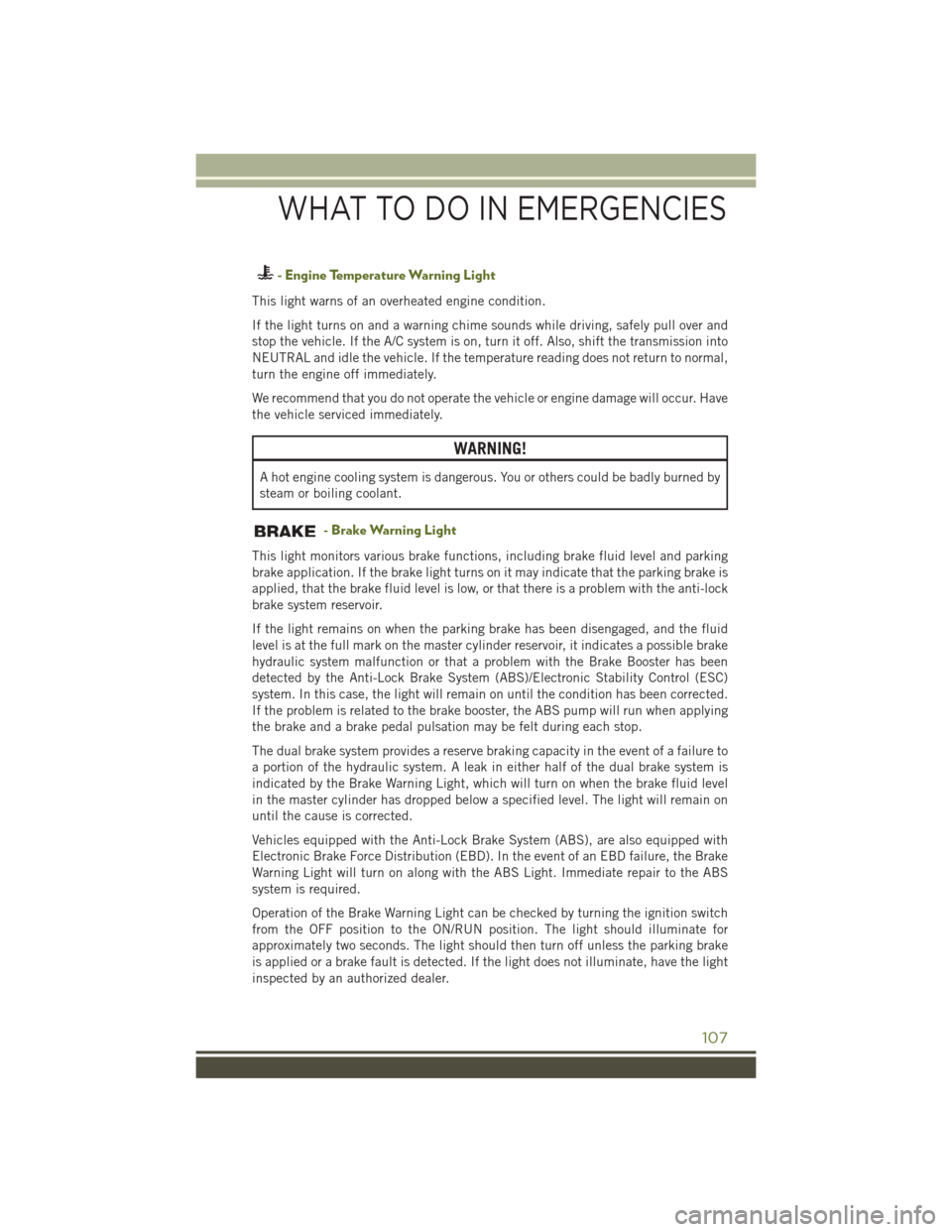
- Engine Temperature Warning Light
This light warns of an overheated engine condition.
If the light turns on and a warning chime sounds while driving, safely pull over and
stop the vehicle. If the A/C system is on, turn it off. Also, shift the transmission into
NEUTRAL and idle the vehicle. If the temperature reading does not return to normal,
turn the engine off immediately.
We recommend that you do not operate the vehicle or engine damage will occur. Have
the vehicle serviced immediately.
WARNING!
A hot engine cooling system is dangerous. You or others could be badly burned by
steam or boiling coolant.
- Brake Warning Light
This light monitors various brake functions, including brake fluid level and parking
brake application. If the brake light turns on it may indicate that the parking brake is
applied, that the brake fluid level is low, or that there is a problem with the anti-lock
brake system reservoir.
If the light remains on when the parking brake has been disengaged, and the fluid
level is at the full mark on the master cylinder reservoir, it indicates a possible brake
hydraulic system malfunction or that a problem with the Brake Booster has been
detected by the Anti-Lock Brake System (ABS)/Electronic Stability Control (ESC)
system. In this case, the light will remain on until the condition has been corrected.
If the problem is related to the brake booster, the ABS pump will run when applying
the brake and a brake pedal pulsation may be felt during each stop.
The dual brake system provides a reserve braking capacity in the event of a failure to
a portion of the hydraulic system. A leak in either half of the dual brake system is
indicated by the Brake Warning Light, which will turn on when the brake fluid level
in the master cylinder has dropped below a specified level. The light will remain on
until the cause is corrected.
Vehicles equipped with the Anti-Lock Brake System (ABS), are also equipped with
Electronic Brake Force Distribution (EBD). In the event of an EBD failure, the Brake
Warning Light will turn on along with the ABS Light. Immediate repair to the ABS
system is required.
Operation of the Brake Warning Light can be checked by turning the ignition switch
from the OFF position to the ON/RUN position. The light should illuminate for
approximately two seconds. The light should then turn off unless the parking brake
is applied or a brake fault is detected. If the light does not illuminate, have the light
inspected by an authorized dealer.
WHAT TO DO IN EMERGENCIES
107
Page 113 of 156

IF YOUR ENGINE OVERHEATS
In any of the following situations, you can reduce the potential for overheating by
taking the appropriate action:
• On the highways — slow down.
• In city traffic — while stopped, shift the transmission to NEUTRAL, but do not
increase engine idle speed.
NOTE:
There are steps that you can take to slow down an impending overheat condition:
• If your air conditioner (A/C) is on, turn it off. The A/C system adds heat to the
engine cooling system and turning the A/C off can help remove this heat.
•You can also turn the temperature control to maximum heat, the mode control to floor
and the blower control to high. This allows the heater core to act as a supplement to
the radiator and aids in removing heat from the engine cooling system.
CAUTION!
Driving with a hot cooling system could damage your vehicle. If the temperature
gauge reads HOT (H), pull over and stop the vehicle. Idle the vehicle with the air
conditioner turned off until the pointer drops back into the normal range. If the
pointer remains on HOT (H), and you hear continuous chimes, turn the engine off
immediately, and call for service.
WARNING!
You or others can be badly burned by hot engine coolant (antifreeze) or steam from
your radiator. If you see or hear steam coming from under the hood, do not open
the hood until the radiator has had time to cool. Never try to open a cooling system
pressure cap when the radiator or coolant bottle is hot.
WHAT TO DO IN EMERGENCIES
111
Page 119 of 156
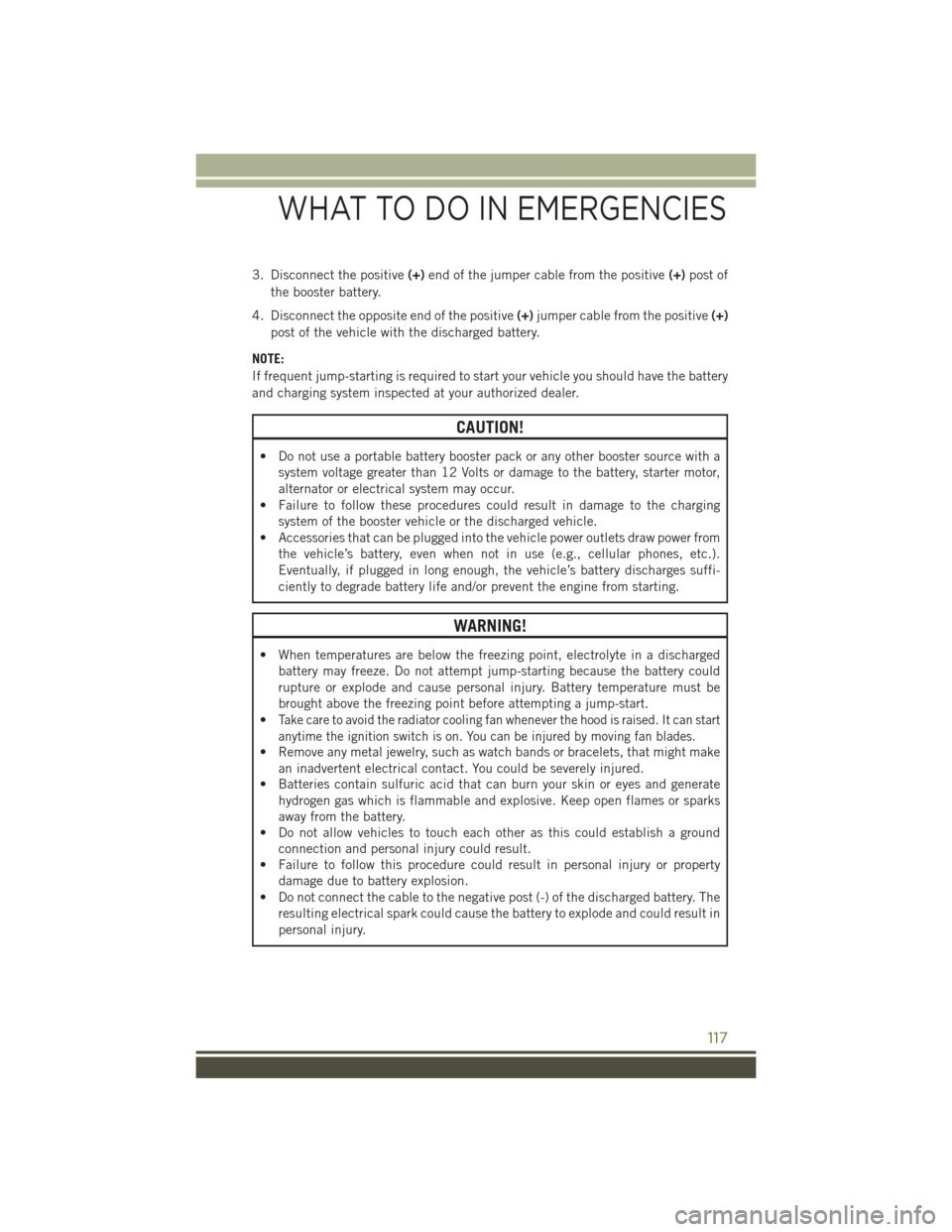
3. Disconnect the positive(+)end of the jumper cable from the positive(+)post of
the booster battery.
4. Disconnect the opposite end of the positive(+)jumper cable from the positive(+)
post of the vehicle with the discharged battery.
NOTE:
If frequent jump-starting is required to start your vehicle you should have the battery
and charging system inspected at your authorized dealer.
CAUTION!
• Do not use a portable battery booster pack or any other booster source with a
system voltage greater than 12 Volts or damage to the battery, starter motor,
alternator or electrical system may occur.
• Failure to follow these procedures could result in damage to the charging
system of the booster vehicle or the discharged vehicle.
• Accessories that can be plugged into the vehicle power outlets draw power from
the vehicle’s battery, even when not in use (e.g., cellular phones, etc.).
Eventually, if plugged in long enough, the vehicle’s battery discharges suffi-
ciently to degrade battery life and/or prevent the engine from starting.
WARNING!
• When temperatures are below the freezing point, electrolyte in a discharged
battery may freeze. Do not attempt jump-starting because the battery could
rupture or explode and cause personal injury. Battery temperature must be
brought above the freezing point before attempting a jump-start.
•Take care to avoid the radiator cooling fan whenever the hood is raised. It can start
anytime the ignition switch is on. You can be injured by moving fan blades.
• Remove any metal jewelry, such as watch bands or bracelets, that might make
an inadvertent electrical contact. You could be severely injured.
• Batteries contain sulfuric acid that can burn your skin or eyes and generate
hydrogen gas which is flammable and explosive. Keep open flames or sparks
away from the battery.
• Do not allow vehicles to touch each other as this could establish a ground
connection and personal injury could result.
• Failure to follow this procedure could result in personal injury or property
damage due to battery explosion.
• Do not connect the cable to the negative post (-) of the discharged battery. The
resulting electrical spark could cause the battery to explode and could result in
personal injury.
WHAT TO DO IN EMERGENCIES
117
Page 126 of 156
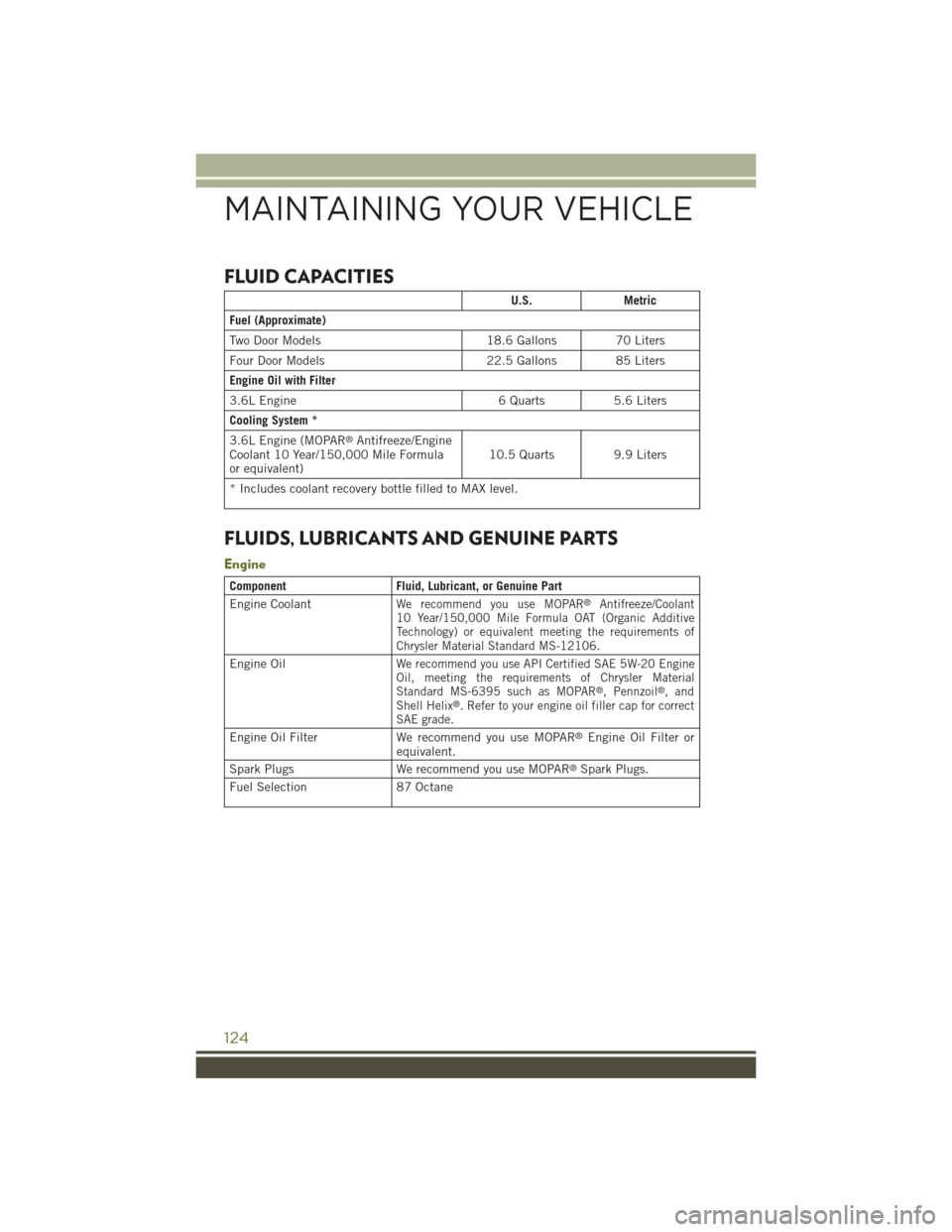
FLUID CAPACITIES
U.S.Metric
Fuel (Approximate)
Two Door Models18.6 Gallons 70 Liters
Four Door Models 22.5 Gallons 85 Liters
Engine Oil with Filter
3.6L Engine 6 Quarts 5.6 Liters
Cooling System *
3.6L Engine (MOPAR®Antifreeze/EngineCoolant 10 Year/150,000 Mile Formulaor equivalent)10.5 Quarts 9.9 Liters
* Includes coolant recovery bottle filled to MAX level.
FLUIDS, LUBRICANTS AND GENUINE PARTS
Engine
ComponentFluid, Lubricant, or Genuine Part
Engine CoolantWe recommend you use MOPAR®Antifreeze/Coolant10 Year/150,000 Mile Formula OAT (Organic AdditiveTechnology) or equivalent meeting the requirements ofChrysler Material Standard MS-12106.
Engine OilWe recommend you use API Certified SAE 5W-20 EngineOil, meeting the requirements of Chrysler MaterialStandard MS-6395 such as MOPAR®, Pennzoil®, andShell Helix®. Refer to your engine oil filler cap for correctSAE grade.
Engine Oil FilterWe recommend you use MOPAR®Engine Oil Filter orequivalent.
Spark PlugsWe recommend you use MOPAR®Spark Plugs.
Fuel Selection87 Octane
MAINTAINING YOUR VEHICLE
124
Page 127 of 156

CAUTION!
• Mixing of engine coolant (antifreeze) other than specified Organic Additive
Technology (OAT) engine coolant (antifreeze), may result in engine damage and
may decrease corrosion protection. Organic Additive Technology (OAT) engine
coolant is different and should not be mixed with Hybrid Organic Additive
Technology (HOAT) engine coolant (antifreeze) or any “globally compatible”
coolant (antifreeze). If a non-OAT engine coolant (antifreeze) is introduced into
the cooling system in an emergency, the cooling system will need to be drained,
flushed, and refilled with fresh OAT coolant (conforming to MS-12106), by an
authorized dealer as soon as possible.
• Do not use water alone or alcohol-based engine coolant (antifreeze) products.
Do not use additional rust inhibitors or antirust products, as they may not be
compatible with the radiator engine coolant and may plug the radiator.
• This vehicle has not been designed for use with propylene glycol-based engine
coolant (antifreeze). Use of propylene glycol-based engine coolant (antifreeze)
is not recommended.
Chassis
ComponentFluid, Lubricant, or Genuine Part
Automatic Transmission –If EquippedUse only ATF+4®Automatic Transmission Fluid. Failure touse ATF+4®fluid may affect the function or performance ofyour transmission. We recommend MOPAR®AT F + 4®fluid.
Manual Transmission –If EquippedWe recommend you use MOPAR®Manual Transmission Lubri-cant meeting the requirements of Chrysler Material StandardMS-9224.
Transfer CaseWe recommend you use MOPAR®AT F + 4®Automatic Trans-mission Fluid.
Axle Differential (Front) We recommend you use MOPAR®Gear & Axle Lubricant(SAE 80W-90) (API GL-5).
Axle Differential (Rear)226 RBI (Model 44)–We recommend you use MOPAR®Gear& Axle Lubricant (SAE 80W-90) (API GL-5) or equivalent. Fortrailer towing, use MOPAR®Synthetic Gear & Axle Lubricant(SAE 75W-140). Models equipped with Trac-Lok™ require anadditive.
Brake Master Cylinder We recommend you use MOPAR®DOT 3 Brake Fluid, SAEJ1703. If DOT 3, SAE J1703 brake fluid is not available,then DOT 4 is acceptable.
Power Steering Reservoir We recommend you use MOPAR®Power Steering Fluid +4,MOPAR®AT F + 4®Automatic Transmission Fluid.
MAINTAINING YOUR VEHICLE
125
Page 129 of 156
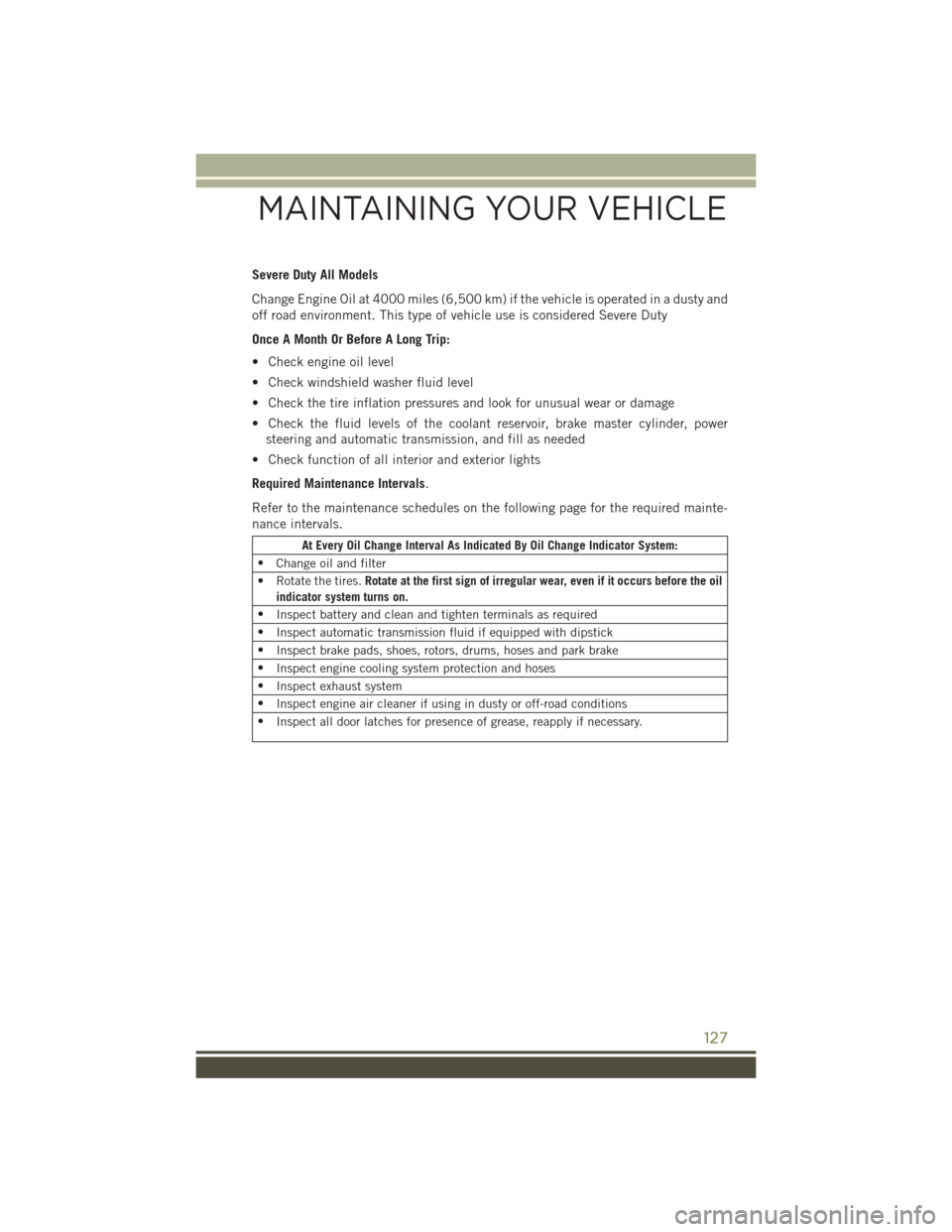
Severe Duty All Models
Change Engine Oil at 4000 miles (6,500 km) if the vehicle is operated in a dusty and
off road environment. This type of vehicle use is considered Severe Duty
Once A Month Or Before A Long Trip:
• Check engine oil level
• Check windshield washer fluid level
• Check the tire inflation pressures and look for unusual wear or damage
• Check the fluid levels of the coolant reservoir, brake master cylinder, power
steering and automatic transmission, and fill as needed
• Check function of all interior and exterior lights
Required Maintenance Intervals.
Refer to the maintenance schedules on the following page for the required mainte-
nance intervals.
At Every Oil Change Interval As Indicated By Oil Change Indicator System:
•Change oil and filter
• Rotate the tires.Rotate at the first sign of irregular wear, even if it occurs before the oil
indicator system turns on.
•Inspect battery and clean and tighten terminals as required
•Inspect automatic transmission fluid if equipped with dipstick
•Inspect brake pads, shoes, rotors, drums, hoses and park brake
•Inspect engine cooling system protection and hoses
•Inspect exhaust system
•Inspect engine air cleaner if using in dusty or off-road conditions
•Inspect all door latches for presence of grease, reapply if necessary.
MAINTAINING YOUR VEHICLE
127
Page 145 of 156
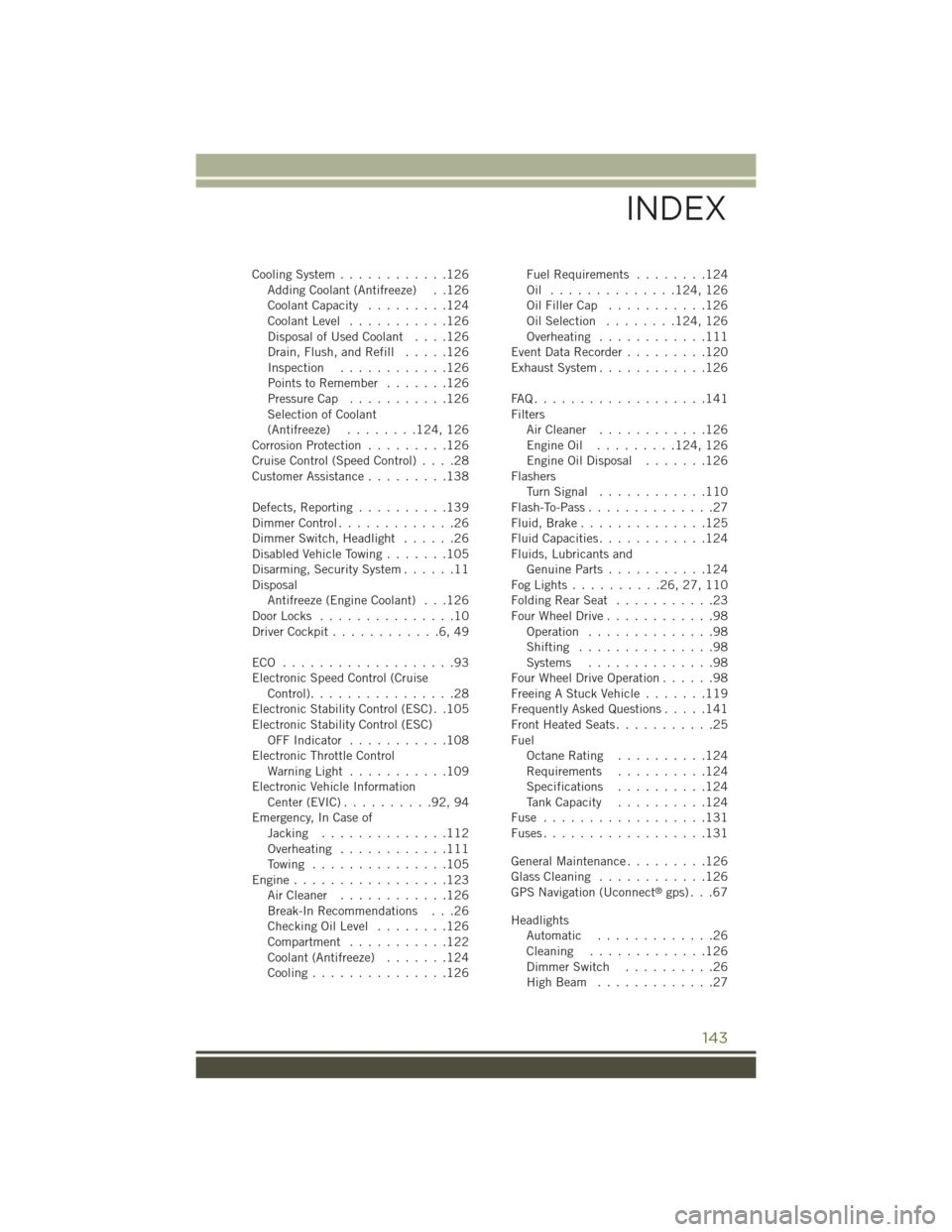
Cooling System............126Adding Coolant (Antifreeze) . .126Coolant Capacity.........124Coolant Level...........126Disposal of Used Coolant....126Drain, Flush, and Refill.....126Inspection............126Points to Remember . . . . . . .126Pressure Cap...........126Selection of Coolant(Antifreeze)........124, 126Corrosion Protection.........126Cruise Control (Speed Control)....28Customer Assistance.........138
Defects, Reporting..........139Dimmer Control.............26Dimmer Switch, Headlight......26Disabled Vehicle Towing.......105Disarming, Security System......11DisposalAntifreeze (Engine Coolant) . . .126Door Locks . . . . . . . . . . . . . . .10Driver Cockpit............6,49
ECO . . . . . . . . . . . . . . . . . . .93Electronic Speed Control (CruiseControl)................28Electronic Stability Control (ESC) . .105Electronic Stability Control (ESC)OFF Indicator...........108Electronic Throttle ControlWarning Light . . . . . . . . . . .109Electronic Vehicle InformationCenter (EVIC) . . . . . . . . . .92, 94Emergency, In Case ofJacking..............112Overheating............111To w i n g . . . . . . . . . . . . . . . 1 0 5Engine . . . . . . . . . . . . . . . . .123Air Cleaner . . . . . . . . . . . .126Break-In Recommendations . . .26Checking Oil Level........126Compartment...........122Coolant (Antifreeze).......124Cooling...............126
Fuel Requirements . . . . . . . .124Oil . . . . . . . . . . . . . .124, 126Oil Filler Cap...........126Oil Selection........124, 126Overheating............111Event Data Recorder.........120Exhaust System............126
FA Q . . . . . . . . . . . . . . . . . . . 1 4 1FiltersAir Cleaner............126Engine Oil . . . . . . . . .124, 126Engine Oil Disposal.......126FlashersTu r n S i g n a l . . . . . . . . . . . . 1 1 0Flash-To-Pass..............27Fluid, Brake..............125Fluid Capacities............124Fluids, Lubricants andGenuine Parts . . . . . . . . . . .124Fog Lights . . . . . . . . . .26, 27, 110Folding Rear Seat . . . . . . . . . . .23Four Wheel Drive............98Operation..............98Shifting...............98Systems..............98Four Wheel Drive Operation......98Freeing A Stuck Vehicle.......119Frequently Asked Questions.....141Front Heated Seats...........25FuelOctane Rating..........124Requirements . . . . . . . . . .124Specifications..........124Tank Capacity..........124Fuse . . . . . . . . . . . . . . . . . .131Fuses . . . . . . . . . . . . . . . . . .131
General Maintenance.........126Glass Cleaning............126GPS Navigation (Uconnect®gps) . . .67
HeadlightsAutomatic.............26Cleaning.............126Dimmer Switch..........26High Beam . . . . . . . . . . . . .27
INDEX
143